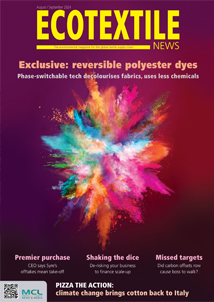WAKEFIELD – The third episode in our new five-part audio documentary examines the challenges of sourcing enough of the right feedstock for chemical textile-to-textile recycling.
Ecotextile Talks speaks to Södra’s Niclas Berg, whose job involves sourcing feedstock for the company's ‘OnceMore’ process, Lina Wiles, head of sustainability in Sweden for Elis, which is currently Södra’s major supplier.
Elis, which supplies garments, towels and bed linen to hotels, hospitals and restaurants in 28 countries in Europe and Latin America, linked up with Södra to find a second life for the textiles it can no longer use.
Wiles said: “We don't want any of our textile waste to have to be sent to energy recovery over the next decade, so we want to find other solutions for it to make the textiles' value stay around and live as long as possible.”
Berg explained why Elis had proved the ideal supply partner: “They only use textiles based on cotton, and polyester-cotton, so we can be quite sure we don't get any kind of fibres which we don't want in our production today. For instance, elastane or other elastics, that’s not really good for chemical recycling,” he said.
“Also, their main feedstock is white, and currently we only want to work with white textiles because we don't have the possibility to remove colour yet.”
However, these limitations mean that Södra needs to find additional suppliers and so the company has also linked up with the Textile Services Association (TSA) whose members meet 90-95 per cent of the laundry needs of the NHS and the hospitality industry in the UK.
The TSA has agreed to sort and collect textile waste from its members for Södra from January 2022. It will take this waste by lorry to British ports from where it will be shipped back to Sweden.
David Stevens, CEO of TSA, said: “One of our challenges has always been end-of-life of a product – what we do with a sheet when it's been washed 100 times... Traditionally, it's gone to the rag trade and been chopped up into wipers, but we've been really keen to try to change that concept of one more use into many more uses.
“We were delighted to catch up with Södra two years ago and start on the journey of fibre-to-fibre technology where a sheet can have lots more lives. So, we can take a sheet, put it back into a pulp, redevelop it into yarn, and hopefully deliver another sheet at the end of the process.”
This episode also looks at the implications of new extended producer responsibility (EPR) schemes, as well as European Union legislation to require separate collections of household textile waste by 2025, both of which offer the potential of hugely increasing the amount of textile waste available for recycling.
However, Martin Böschen, CEO of Texaid, the largest collector and sorter of textile waste in Europe, says he would initially need to charge a higher price to chemical recyclers because of the additional complexity of their needs, at least until the industry develops.
“Who is going to scale up first? They cannot scale up before us but we cannot scale up before them so we need to go hand-in-hand,” he said.
Anna Granskog, a partner at McKinsey & Company, agreed, saying: "Somehow to get to scale we need to de-risk the scaling so that the economic risk that any party takes is not outrageous."
Subscribe to our podcasts and radio shows by following us on Apple, Google, Spotify and Amazon Music, to automatically get alerts when we launch a new Ecotextile Talks Behind the News podcast.







































